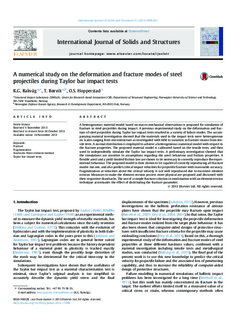| dc.contributor.author | Rakvåg, Kristian Gaarder | |
| dc.contributor.author | Børvik, Tore | |
| dc.contributor.author | Hopperstad, Odd Sture | |
| dc.date.accessioned | 2017-11-08T11:52:20Z | |
| dc.date.available | 2017-11-08T11:52:20Z | |
| dc.date.created | 2014-03-20T14:53:10Z | |
| dc.date.issued | 2014 | |
| dc.identifier.citation | International Journal of Solids and Structures. 2014, 51 (3-4), 808-821. | nb_NO |
| dc.identifier.issn | 0020-7683 | |
| dc.identifier.uri | http://hdl.handle.net/11250/2464921 | |
| dc.description.abstract | A heterogeneous material model based on macro-mechanical observations is proposed for simulation of fracture in steel projectiles during impact. A previous experimental study on the deformation and fracture of steel projectiles during Taylor bar impact tests resulted in a variety of failure modes. The accompanying material investigation showed that the materials used in the impact tests were heterogeneous on scales ranging from microstructure as investigated with SEM to variation in fracture strains from tensile tests. A normal distribution is employed to achieve a heterogeneous numerical model with respect to the fracture properties. The proposed material model is calibrated based on the tensile tests, and then used to independently simulate the Taylor bar impact tests. A preliminary investigation showed that the simulations are sensitive to assumptions regarding the anvil behaviour and friction properties. A flexible anvil and a yield-limited friction law are shown to be necessary to correctly reproduce the experimental behaviour. The proposed model is then shown to be capable of correctly reproducing all fracture modes but one, and also predict critical impact velocities for projectile fracture with reasonable accuracy. Fragmentation at velocities above the critical velocity is not well reproduced due to excessive element erosion. Measures to make the element erosion process more physical are proposed and discussed with their respective drawbacks. The use of a simple fracture criterion in combination with an element erosion technique accentuates the effect of distributing the fracture parameter. | nb_NO |
| dc.language.iso | eng | nb_NO |
| dc.publisher | Elsevier | nb_NO |
| dc.title | A numerical study on the deformation and fracture modes of steel projectiles during Taylor bar impact tests | nb_NO |
| dc.type | Journal article | nb_NO |
| dc.type | Peer reviewed | nb_NO |
| dc.description.version | publishedVersion | nb_NO |
| dc.source.pagenumber | 808-821 | nb_NO |
| dc.source.volume | 51 | nb_NO |
| dc.source.journal | International Journal of Solids and Structures | nb_NO |
| dc.source.issue | 3-4 | nb_NO |
| dc.identifier.doi | 10.1016/j.ijsolstr.2013.11.008 | |
| dc.identifier.cristin | 1123602 | |
| dc.relation.project | Norges forskningsråd: 174834 | nb_NO |
| dc.description.localcode | © 2013 Elsevier Ltd. All rights reserved. Published under an Elsevier user license. Users may access, download, copy, translate, text and data mine (but may not redistribute, display or adapt) the articles for non-commercial purposes). | nb_NO |
| cristin.unitcode | 194,64,45,0 | |
| cristin.unitname | Institutt for konstruksjonsteknikk | |
| cristin.ispublished | true | |
| cristin.fulltext | postprint | |
| cristin.qualitycode | 1 | |
